Ferny Grove State High Fish Snapshot - 2
Fish life measured at Cedar
Creek - 2
Analysis of water samples
You'll remember we just took the water
quality samples and obviously with clean dry containers so we don't
contaminate the samples. We did this so that we can get the
samples fresh before any accidental stirring up of the water such as
when we start to "trawl" or net for fish life.
We analyse the water samples for various
water quality properties, such as pH and clarity. Hayley Cambourn
demonstrates the measurement of clarity as the property, turbidity, in
the first pictures below.
Sampling of fish life
There are two ways we can use to sample the
the number and type of fish. Both depend upon stealth so as not to
frighten the fish and therefore miss them! Each has its own
advantages and disadvantages so we use both ways.
Active fish trapping requires the use of
special fish nets. There are various designs of fishing nets that are
handled manually by "brave souls" who don't mind getting their feet wet
(or use wellington boots!). These nets are often rectangular in shape
and the handlers trawl for fish by sweeping them through likely pools
of water. The quality of sampling may depend upon our skill. There is
one disadvantage in that the process tends to stir up the bottom and
increase the turbidity of the water, thereby causing the fish to
scatter and become harder to sample.
We always "trawl" upstream from the lowest point so that we don't ruin
the water for representative sampling. We generally don't do any such
sampling unless the water quality samples have been taken AND all
static trap sampling has been completed in the area.
|
|
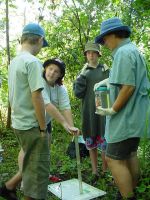
Hayley Cambourn shows how turbidity
measurements are taken.
|
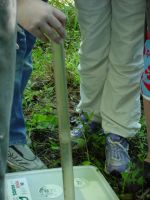
Here is a close-up of the big tube
containing the water sample
|
|
|
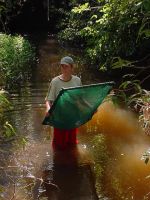
A large fish net is used for "snap sampling"
of streams. James prepares to sample.
|
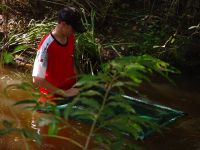
Chris checks the catch. You can get
fairly wet at times if you don't wear your gum-boots!
|
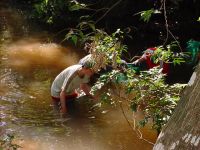
James, Daniel and Chris using a new
strategy
|
|
We use special traps for static trapping of
fish. This type of sampling is less disruptive but relies upon our
selection of the correct bait to attract the wide range of types
of fish that might be present. Typically, we use prawns because
they can be purchased and attract most fish. You'll see
there is a pocket of the trap in which we tuck away the
bait. Michael, Daniel, James and Chris watch John set the trap.
We'll need more than the one trap for the relatively large section of
creek we'll be surveying.
|
|
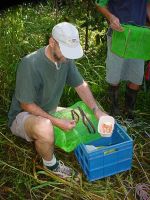
John Beumer adds the prawns to the trap
pouch (real ones, no cat food for us!).
|
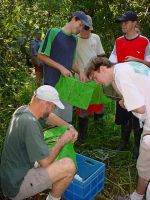
The boys watch and prepare their static
traps.
|

You throw the trap on a line into a likely
spot for the fish
|
|
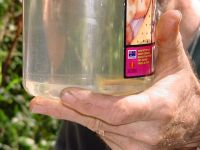
Here's a suitable jar for us to hold our
water sample to see the fish.
|
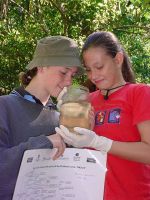
Hannah and Elise check their fish against
the details given in their Identification Chart.
|
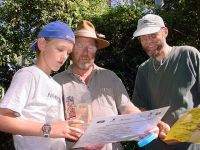
The Chart allows step by step
identification of all the main types of fish
|
Identification of our fish
Once we catch our fish in either type of
trap we carefully transfer the fish into our clean glass or plastic
jars containing adequate fresh water from the stream. Now we can take
our time and observe the various features of each fish.
We look at the body shape and size, the
number and types of fins and tail, and the nature and distribution of
any colour over the body of fish. We record all these details on our
observation data sheets and then compare them against a special
identification flow chart. This chart gives step by step instructions
leading by a process of acceptance and elimination of choices to a
decision as to the type of fish being examined.
You may download a PDF copy of this chart and the "Standard procedures for conducting a community fish monitoring program", specially compiled by Brisbane
Waterwatch for these Fish Snapshots from the Downloads page.
|
|
CI 14/10/2011